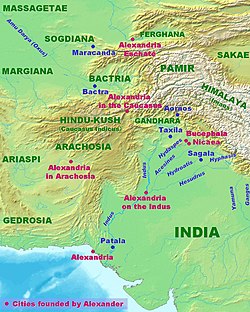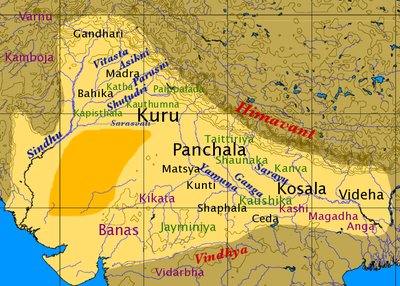References in Mahabharata
There is a town of the name of Sakala, a river of the name of Apaga, and a clan of the Vahikas known by the name of the Jarttikas (Mbh 8:44). Nakula, proceeding to Sakala, the city of the Madras, made his uncle Shalya accept from affection the sway of the Pandavas(Mbh 2:31).
Destruction by Alexander

The city appears in the accounts of Alexander the Great's conquests of Persia's eastern provinces in Asia. After crossing the Hydraotes, Alexander, joined by Porus with elephants and 5,000 local troops, laid siege to Sagala, where the Cathaeans had entrenched themselves. The city was razed to the ground, and many of its inhabitants killed:
- "The Cathaeans... had a strong city near which they proposed to make their stand, named Sagala. (...) The next day Alexander rested his troops, and on the third advanced on Sangala, where the Cathaeans and their neighbours who had joined them were drawn up in front of the city. (...) At this point too, Porus arrived, bringing with him the rest of the elephants and some five thousand of his troops. (...) Alexander returned to Sangala, razed the city to the ground, and annexed its territory". Sagala was rebuilt and established as an outpost and incorporated into Alexander's vast empire. I was the most easternmost outpost established by Alexander and remained a center of Hellenistic influence for quite some time after.Arrian, Anabasis of Alexander, V.22-24
Sunga period

Following his overthrowing of the Mauryan Empire, Pusyamitra Sunga established theSunga Empire and expanded northwest as far as Sagala. According to the 2nd centuryAshokavadana:
- "Then King Pusyamitra equipped a fourfold army, and intending to destroy the Buddhist religion, he went to the Kukkutarama. (...) Pusyamitra therefore destroyed thesangharama, killed the monks there, and departed.
- After some time, he arrived in Sakala, and proclaimed that he would give a hundred dinara reward to whoever brought him the head of a Buddhist monk" (Shramanas)Ashokavadana, 133, trans. John Strong.
Indo-Greek rule
Sagala was used as a capital by the Greco-Bactrian (alternatively Indo-Greek or Graeco-Indian) king Menander during his reign between 160 and 135 BCE
Though many Graeco-Bactrian, and even some Indo-Greek cities were designed along Greek architectural lines. In contrast to other imperialist governments elsewhere, literary accounts suggests the Greeks and the local population of cities like Sagala lived in relative harmony, with some of the local residents adopting the responsibilities of Greek citizenship - and more astonishingly, Greeks converting to Buddhism and adopting local traditions.
The best descriptions of Sagala however, come from the Milinda Panha, a dialogue between king Menander and the Buddhist monk Nagasena. Historians like Sir Tarn believe this document was written around 100 years after Menander's rule, which is one of the best enduring testimonies of the productiveness and benevolence of his rule, which has made the more modern theory that he was regarded as a Chakravartin - King of the Wheel or literally Wheel-Turner in Sanskrit - generally accepted.
In the Milindapanha, the city is described in the following terms:
- "There is in the country of the Yonakas a great centre of trade, a city that is called Sgala, situate in a delightful country well watered and hilly, abounding in parks and gardens and groves and lakes and tanks, a paradise of rivers and mountains and woods. Wise architects have laid it out, and its people know of no oppression, since all their enemies and adversaries have been put down. Brave is its defence, with many and various strong towers and ramparts, with superb gates and entrance archways; and with the royal citadel in its midst, white walled and deeply moated. Well laid out are its streets, squares, cross roads, and market places. Well displayed are the innumerable sorts of costly merchandise with which its shops are filled. It is richly adorned with hundreds of alms-halls of various kinds; and splendid with hundreds of thousands of magnificent mansions, which rise aloft like the mountain peaks of the Himalayas. Its streets are filled with elephants, horses, carriages, and foot-passengers, frequented by groups of handsome men and beautiful women, and crowded by men of all sorts and conditions, Brahmans, nobles, artificers, and servants. They resound with cries of welcome to the teachers of every creed, and the city is the resort of the leading men of each of the differing sects. Shops are there for the sale of Benares muslin, of Kotumbara stuffs, and of other cloths of various kinds; and sweet odours are exhaled from the bazaars, where all sorts of flowers and perfumes are tastefully set out. Jewels are there in plenty, such as men's hearts desire, and guilds of traders in all sorts of finery display their goods in the bazaars that face all quarters of the sky. So full is the city of money, and of gold and silver ware, of copper and stone ware, that it is a very mine of dazzling treasures. And there is laid up there much store of property and corn and things of value in warehouses-foods and drinks of every sort, syrups and sweetmeats of every kind. In wealth it rivals Uttara-kuru, and in glory it is as lakamand, the city of the gods". (The Questions of King Milinda, Translation by T. W. Rhys Davids, 1890)
Later times
Sagala was described as "Sagala or Euthydemia" in the Geography of Ptolemy in the 1st century CE.
Incidentally, Sagala was also the capital of the Indo-Hepthalite King Mihirakula.































